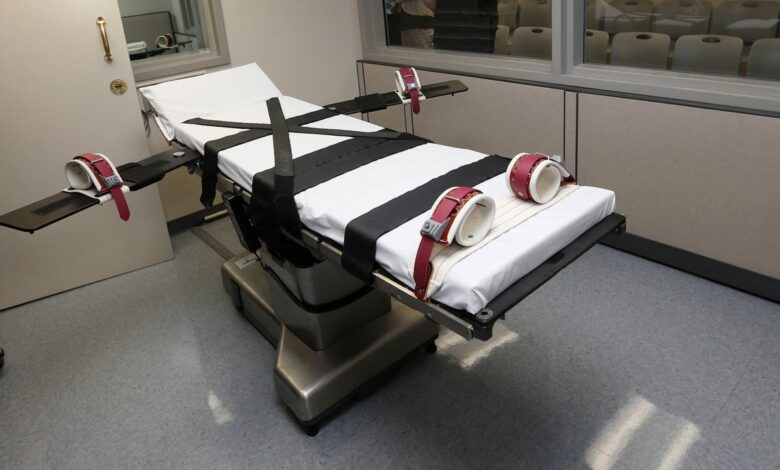Racism, gruesome errors, and botched executions: Inside America’s four-person, 48-hour execution spree

On a cold morning last Wednesday, in the execution chamber at the Eyman prison in Florence, Arizona, a 76-year-old named Murray Hooper, convicted of a 1980 double murder, lay strapped to a gurney, awaiting lethal injection.
Officials failed multiple times to place an IV that would deliver the execution drugs, resorting to placing a catheter in the man’s femoral artery, near his groin.
He turned towards the gallery, looked at the witnesses on the other side of the glass, and reportedly said, “Can you believe this?” before later being pronounced dead at 10.34am.
Even for America, one of few countries globally which still uses the death penalty, last week was exceptionally violent, with four executions planned in the span of 48 hours. The killings were marred with errors, accusations of racism and discrimination, and claims of innocence. One was called off after officials took more than an hour and were unable to place an IV line.
In Texas on Wednesday, Stephen Barbee, 55, was killed, after being convicted in the February 2005 killing of his pregnant ex-girlfriend and her young son.
It took an hour-and-a-half for officials find a vein to deliver the lethal injection drugs.
Barbee’s lawyers said the state wasn’t properly following a March US Supreme Court decision requiring that states respect the requests of the condemned to have faith leaders with them in the execution room.
“The recent spate of botched lethal injection executions have shown that whatever the drug, whatever the protocol, condemned prisoners often spend their final moments in agonizing pain and distress,” Maya Foa, director of advocacy group Reprieve US, said in a statement after the execution.
“Establishing IV access is difficult, even for trained medical professionals,” she added. “Prison officials often struggle to find a vein, subjecting the prisoner to a lengthy ordeal of stabs and cuts. With each gruesome scene in the death chamber, we are witnessing the consequences of persisting with a broken method of execution in real time.”
The following day, Oklahoma executed Richard Fairchild, 63, for murdering his girlfriend’s three-year-old son in 1993.
Fairchild’s attorneys said he grew up in an abusive home, suffered from alcohol and substance abuse at a young age, and developed head trauma as a teen boxer, all of which may have impaired his moral judgment later on. Despite these warning signs, his original attorneys never raised them before the court, even though the Supreme Court has found such factors could rule out a death sentence.
“We shouldn’t have to hold up signs on the road that say ‘Don’t Kill the Mentally Ill’ and ‘Stop Executing Veterans.’ This is the fourth person with mental illness and brain damage that the State has executed in 2022,” Reverend Don Heath, chair of the Oklahoma Coalition to Abolish the Death Penalty, said in a statement. “No end is in sight. We have 23 more executions scheduled in the next 26 months. Oklahoma is ruled by people with hard hearts.”
Perhaps the most controversial of these executions was that of Hooper in Arizona.
Critics say his case is tainted with bias and dubious evidence, as well as corrupted by the involvement of the Chicago Police Department during a period notorious for racism, the abuse and torture of suspects, and numerous false convictions that were later overturned. The story is indicative of the labyrinthine process of capital convictions and near impossibility of slowing the execution machine once it reaches a conclusion.
In November of 1980, Hooper allegedly committed a triple murder in Illinois, then a contract killing double murder in Phoenix the following month. Hooper was well known to Chicago police for past involvement in gang activity, but wasn’t arrested until he was named as a suspect in the Arizona case.
Murray Hooper
In custody in Illinois, Mr Hooper said he was threatened with suffocation, and had officers jam their fingers down his throat. Years later, his death sentence there was eventually thrown out in appeals court, after a panel found evidence of potential racial bias during his trial was ignored. But by then it was too late. The Illinois conviction helped persuade courts in Arizona to grant a death sentence.
In the Arizona case, prosecutors alleged Hooper was part of a trio of hitmen hired to kill William “Pat” Redmond, on behalf of a mobbed up business man seeking to take control of Redmond’s printing business and its lucrative potential work with Las Vegas casinos.
Only one witness survived the shooting, Redmond’s wife Marilyn. At various points, she claimed the attack was carried out by three Black men, by two Black men and a clean cut white man in a suit, and told detectives she wouldn’t be able to recognise anyof the suspects.
There was no physical evidence that Hooper was involved in the Phoenix shooting, so prosecutors relied heavily on Ms Redmond’s testimony. Officials said she had picked Hooper and a co-defendant William Bracy out of a lineup, though there wasn’t any written record or recorded interviews with police about the positive identification, despite officials possessing a video recording of Ms Redmond attempting to identify a third defendant.
Richard Fairchild
Kenneth Eugene Smith





